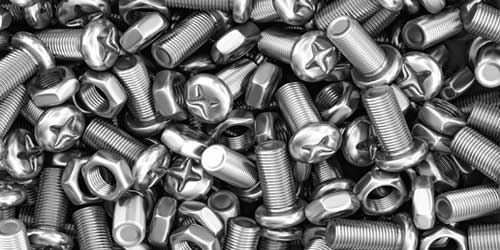Overview
Metal fasteners like screws, nuts, bolts, rivets are used on a large scale in a myriad of applications. Though these fasteners appear to be unimportant and small on the contrary they perform a very major role in giving strength to gigantic structures like bridges, buildings, rail tracks, electrical machines like generators and turbines. These fasteners are used for making joints, holding objects and in conjunction with mating bolts. So the overall strength of fasteners is its toughness.
Manufacturing process
Fasteners like nuts & bolts or studs undergo extreme manufacturing processes like straightening, cold forging, threading, heat treatment or galvanizing. In the process of straightening of raw steel wire and after cold forging, the material loses its property of toughness and might become brittle. Therefore it undergoes a very essential process called heat treatment during which the bolts are heated at desired temperatures to rearrange its molecular structure and regain robustness.

Problem Statement
To reconstruct the molecules of steel to make it more strong, bolts (fasteners) undergo heat treatment. For this, high temperature electric furnaces are used. The heat treatment is called Tempering. Tempering is a three-stage method, and any deviation in the applied temperature may lead to brittle fasteners. This requires continuous monitoring and recording of values of furnace temperature. Hence, a device capable of recording these readings for different instants of time is required.
Solutions
In the process of tempering, the type and condition of tempering equipment and temperature uniformity plays a critical role. Tight temperature uniformity, typically ±5.5°C is required throughout the load, with ±2.75°C preferred especially for high-speed and precipitation hardening steels. It is important to know what is happening to the part microstructure at the selected tempering temperature.
A solution demanded by the application is one that can provide recording of temperatures from 6 different inputs of three furnace zones. To cater this need, KD7 a paperless recorder with 3 temperature inputs and 3 analog inputs (mV) is equipped. Continuous monitoring of readings can be done on the screen of the recorder as well as on the device software. The data can be logged according to user-settable time intervals. Temperature inputs for every 30min are plotted against time. The graphical representation of temperature value is then used for reporting and analysis purposes.
The below figure shows replication of KD7 software screen.
Benefits
- Ease of recording and analysis reduces chances of errors due to human intervention
- Data on KD7 can be viewed in various forms viz. linear diagrams, digital indicators, analog views, bar graphs, tables, and these views can be switched manually this helps understand data more effectively
- Data can be downloaded in .csv format, this enables plotting of graph and printing for reporting/documentation
- The flexibility of operation by providing user-settable input parameters and time intervals
- Defects in the finished product due to inappropriate temperature in the furnace can be traced down easily with the help of records
Available features
- Data archiving on CompactFlash card, capacity up to 4 GB
- IP65 protection grade on the front panel
- Up to 24 measuring channels
- RS-232, RS-485, and USB serial interfaces
- ETHERNET communication, WWW and FTP server, Modbus slave TCP/IP

